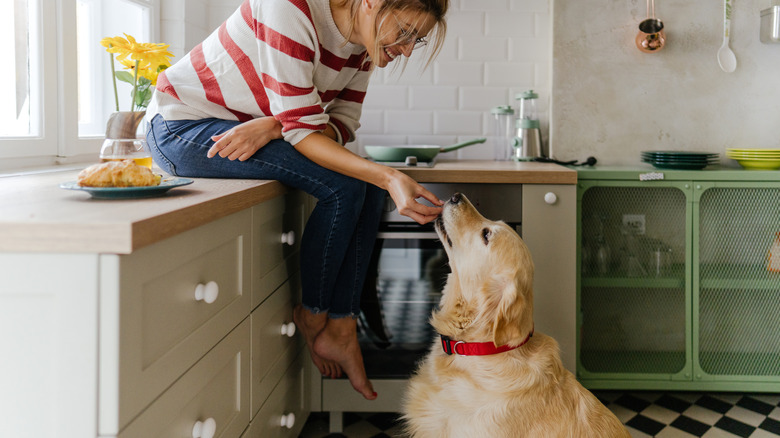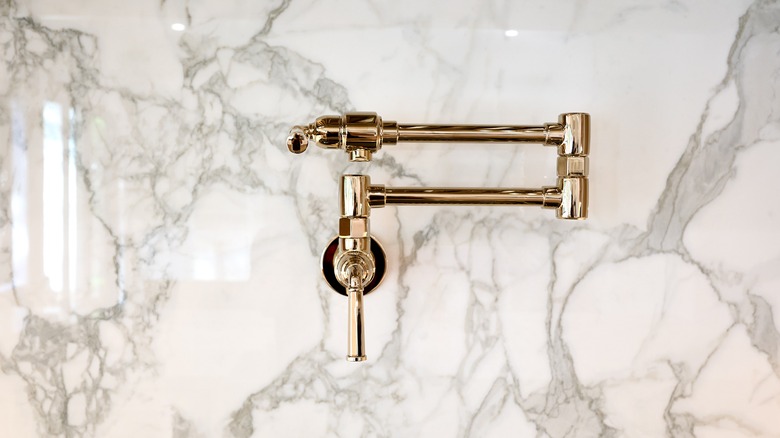The Pot Filler Upgrade Pet Owners Should Consider For Their Next Kitchen Project
Retrofitting your kitchen with a pot filler can be a daunting project. You typically have to deal with a backsplash, and there's often not a water line anywhere near the cooktop where you'd want the new faucet. But, adding a pot filler low on the end of a kitchen cabinet for filling pet water bowls can be a simple and inexpensive project, at least until your dog figures out how to turn the pot filler on and leaves water running on your kitchen floor for eight hours. Assuming your dog is less ambitious, it's quite possible to install a pot filler, like the one TikTok creator @joyfullygreen installed for her pup Ollie, for around $100.
Okay, for $100, yours wouldn't be exactly like @joyfullygreen's, which is inset into her cabinets and trimmed out with the same marble as her countertops, similar to how The Property Brothers did it when creating a pet-friendly kitchen. But, yours would be the same style of double-jointed swing-spout pot filler, mounted to the end of a cabinet, and getting water via a nearby sink's supply line. You can get as fancy as you want, but the basic design can easily be completed in an afternoon. And, the neat thing about it is that none of the cons and all the pros of having a pot filler faucet in your kitchen apply to this easy, inexpensive, and low-risk project.
Preparing for a successful project
This is an easy DIY project, but even if you're hiring a plumber to add your pet's pot filler, it's a good idea to understand what's required. The most important thing you'll need is space at the end of a cabinet that has a sink in it somewhere and a door on the front rather than drawers all the way down. The cabinet's end shouldn't be obstructed by walls or appliances, so you can place a pet's food and water bowls there. Having a sink along the cabinet's length is necessary so you can tie into the sink's cold-water line rather than opening up walls, drilling through studs, and running a new water line to your dog or cat's bowl filler.
If you have an appropriate space, your parts list will also be simple. Basically, you'll need a sink faucet supply line and adapter (or extension) long enough to reach from your sink to the pot filler, a tee or splitter so you can tap into the sink's line, and the pot filler itself. Make sure everything connects properly before installing. The tools required can be pretty basic, as well. You'll need a hole saw or spade bit sized for your faucet's installation requirements, a couple of adjustable wrenches for tightening fittings, PTFE tape, and any tools your faucet-maker recommends for mounting it to a wood surface.
Installing your pet's pot filler
To install the pot filler, first inspect the inside of your cabinets for a good route for the supply line, ensuring everything will reach. Drill holes between units inside the cabinets to run the new water line through, making sure any nearby drawers and slides will continue to function properly with the water line installed. If you're replacing the shutoff valve for your kitchen sink, turn off the water to the house before going any further. Put a towel down to catch any water remaining in the supply lines, then use the adjustable wrenches to remove the existing shutoff valve. Install the replacement valve and reconnect your sink's supply line to one of the outlets. Connect your new supply line to the other.
How you install the pot filler itself will depend on the model you purchase. Some will include a mounting bracket, and others will require that you stub out the cold water line. Follow the installation instructions for connecting the water line, which might require that you attach a board for support. After that, you'll typically screw on the faucet, making sure it's level. Then, screw its flange to your cabinet, and cover it with a decorative ring. Along the way, use PTFE tape to seal connections as directed, and check for leaks at every connection after turning the water back on. Once complete, the days of carrying water bowls to and from the sink are over. You now have direct access to fresh, cold water for your pets.

